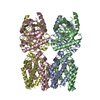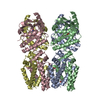+Search query
-Structure paper
| Title | Activation of human STING by a molecular glue-like compound. |
|---|---|
| Journal, issue, pages | Nat Chem Biol, Vol. 20, Issue 3, Page 365-372, Year 2024 |
| Publish date | Oct 12, 2023 |
 Authors Authors | Jie Li / Stephen M Canham / Hua Wu / Martin Henault / Lihao Chen / Guoxun Liu / Yu Chen / Gary Yu / Howard R Miller / Viktor Hornak / Scott M Brittain / Gregory A Michaud / Antonin Tutter / Wendy Broom / Mary Ellen Digan / Sarah M McWhirter / Kelsey E Sivick / Helen T Pham / Christine H Chen / George S Tria / Jeffery M McKenna / Markus Schirle / Xiaohong Mao / Thomas B Nicholson / Yuan Wang / Jeremy L Jenkins / Rishi K Jain / John A Tallarico / Sejal J Patel / Lianxing Zheng / Nathan T Ross / Charles Y Cho / Xuewu Zhang / Xiao-Chen Bai / Yan Feng /  |
| PubMed Abstract | Stimulator of interferon genes (STING) is a dimeric transmembrane adapter protein that plays a key role in the human innate immune response to infection and has been therapeutically exploited for its ...Stimulator of interferon genes (STING) is a dimeric transmembrane adapter protein that plays a key role in the human innate immune response to infection and has been therapeutically exploited for its antitumor activity. The activation of STING requires its high-order oligomerization, which could be induced by binding of the endogenous ligand, cGAMP, to the cytosolic ligand-binding domain. Here we report the discovery through functional screens of a class of compounds, named NVS-STGs, that activate human STING. Our cryo-EM structures show that NVS-STG2 induces the high-order oligomerization of human STING by binding to a pocket between the transmembrane domains of the neighboring STING dimers, effectively acting as a molecular glue. Our functional assays showed that NVS-STG2 could elicit potent STING-mediated immune responses in cells and antitumor activities in animal models. |
 External links External links |  Nat Chem Biol / Nat Chem Biol /  PubMed:37828400 / PubMed:37828400 /  PubMed Central PubMed Central |
| Methods | EM (single particle) |
| Resolution | 2.9 - 4.0 Å |
| Structure data | EMDB-29281, PDB-8flk: EMDB-29282, PDB-8flm: |
| Chemicals |  ChemComp-1SY:  ChemComp-Y6H:  ChemComp-9IM: |
| Source |
|
 Keywords Keywords |  IMMUNE SYSTEM / STING / IMMUNE SYSTEM / STING /  innate immunity / innate immunity /  molecular glue molecular glue |
 Movie
Movie Controller
Controller Structure viewers
Structure viewers About Yorodumi Papers
About Yorodumi Papers








